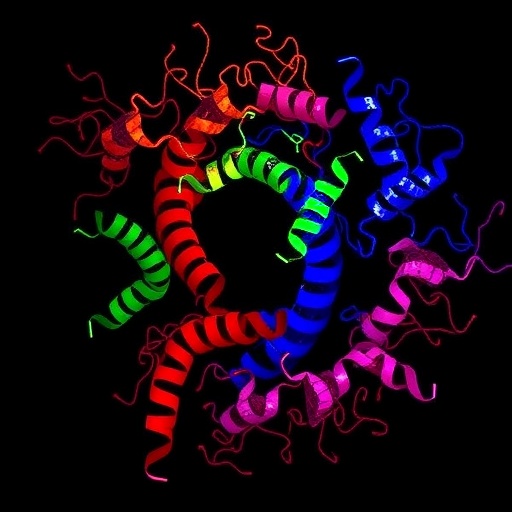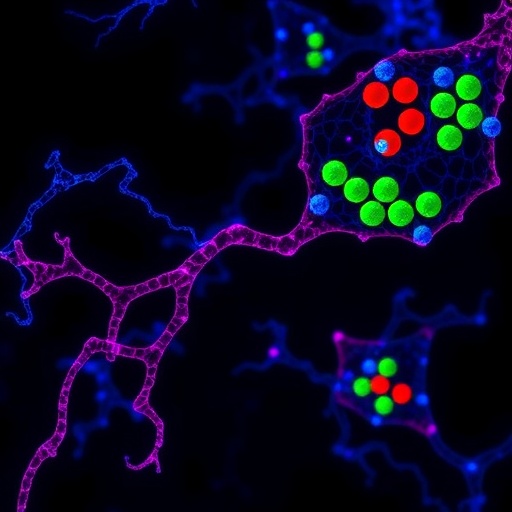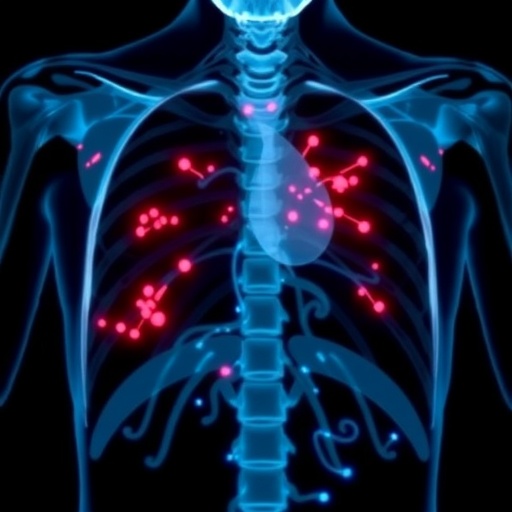
In a groundbreaking advancement that could redefine therapeutic approaches for neurodegenerative diseases, researchers have unveiled compelling evidence highlighting the efficacy of a novel investigational compound, DNL343, as an activator of the eIF2B complex. This discovery is particularly significant in the context of amyotrophic lateral sclerosis (ALS) and related pathologies marked by TDP-43 protein aggregation. The study, recently published in Nature Communications, sheds light on how modulation of the integrated stress response (ISR) through DNL343 can recalibrate cellular homeostasis, offering hope for a condition long burdened by limited treatment options.
The integrated stress response is a fundamental cellular mechanism tasked with maintaining proteostasis under a variety of stress conditions, including viral infections, nutrient deprivation, and protein misfolding. Central to the ISR’s regulation is the eukaryotic initiation factor 2B (eIF2B), a guanine nucleotide exchange factor critical for the initiation of mRNA translation. In numerous neurodegenerative diseases, notably ALS, dysfunction of eIF2B leads to impaired protein synthesis and exacerbated cellular stress, culminating in neuronal death. The newly introduced compound, DNL343, specifically targets and activates the eIF2B complex, thereby potentially restoring translational capacity and mitigating downstream pathological cascades.
The research encompasses an intricate series of preclinical experiments using cellular and animal models that recapitulate TDP-43 pathology, a hallmark of ALS and other neurodegenerative disorders. TDP-43, a DNA/RNA-binding protein, is notorious for its abnormal cytoplasmic aggregation that disrupts normal RNA processing and neuronal function. Intriguingly, the application of DNL343 in these models demonstrated a noteworthy attenuation in pathological TDP-43 aggregates. This beneficial effect coincided with normalization of ISR markers and improvement in behavioral phenotypes, providing tangible proof of concept for eIF2B activation as a therapeutic modality.
.adsslot_N95nwKFZBq{width:728px !important;height:90px !important;}
@media(max-width:1199px){ .adsslot_N95nwKFZBq{width:468px !important;height:60px !important;}
}
@media(max-width:767px){ .adsslot_N95nwKFZBq{width:320px !important;height:50px !important;}
}
ADVERTISEMENT
Beyond the molecular and animal studies, the investigation further extends to a tightly controlled randomized clinical trial involving individuals diagnosed with ALS. The trial’s design underscored rigorous evaluation of safety, pharmacodynamics, and preliminary efficacy of DNL343. Remarkably, patients treated with the compound displayed modulated ISR signaling, affirming the compound’s activity in a human biological context. Although longer term studies are required to elucidate clinical outcomes fully, these findings herald a promising avenue for the modulation of stress responses as a disease-modifying strategy.
A substantial hurdle in the development of ALS therapies has been the heterogeneity of the disease and complexity of underlying pathogenic mechanisms. The integrated stress response, however, represents a convergent pathway implicated across diverse neurodegenerative conditions, making it an attractive target. By directly enhancing eIF2B activity, DNL343 sidesteps some of the pitfalls associated with upstream ISR inhibition, which can lead to undesirable side effects. This nuanced approach allows for a carefully balanced recalibration of protein synthesis without compromising the protective adaptive stress responses necessary for cell survival.
Crucially, the study’s underlying methodology involved the use of cutting-edge biochemical assays to discern the binding dynamics of DNL343 with the eIF2B complex. These analyses revealed that DNL343 stabilizes eIF2B’s active conformation, thereby enhancing its guanine nucleotide exchange function. Such mechanistic insights afford researchers the opportunity to rationally optimize the compound’s efficacy and specificity, setting a precedent for subsequent drug development in this realm.
In the broader context of therapeutic interventions for neurodegenerative disorders, DNL343’s mode of action aligns with a growing body of evidence emphasizing the restoration of proteostasis as a pivotal strategy. Unlike approaches that merely target symptomatic relief or downstream effects, these findings spotlight a pathway that addresses fundamental cellular dysfunction. This molecular focus could recalibrate how the scientific community conceptualizes disease modification, potentially translating into broader applications beyond ALS.
The trial involved extensive biomarker analyses, in which researchers tracked markers indicative of ISR activity, TDP-43 pathology, and neuronal health. These biomarkers provided quantifiable metrics to validate the biological impact of DNL343 administration. The data suggest that modulation of eIF2B activity yields favorable shifts in these crucial parameters, supporting the feasibility of ISR-targeted therapies in a clinical setting.
One of the most compelling aspects of the research lies in its multidisciplinary approach, integrating molecular biology, pharmacology, and clinical sciences. Such a comprehensive strategy has proven essential in unraveling the complexities inherent in neurodegeneration. Importantly, the transition from promising preclinical results to human trials exemplifies a translational milestone, bringing the potential of eIF2B activation therapies closer to real-world application.
While the path forward necessitates expanded trials to establish long-term safety and efficacy comprehensively, the foundational work presented by Flores and colleagues charts a new map for therapeutic exploration. It invites a paradigm shift that may spur the development of analogs or combinatorial regimens targeting the ISR pathway in conjunction with other modalities, amplifying therapeutic potential.
Furthermore, the study’s findings may reverberate beyond the sphere of ALS and TDP-43-linked diseases. Given that ISR dysregulation is implicated in a spectrum of pathological contexts—ranging from Alzheimer’s disease to Parkinsonian syndromes—the implication of eIF2B activators like DNL343 could extend to these disorders as well. Future investigations are poised to explore these exciting possibilities, potentially ushering in a new era of neuroprotective treatments.
A critical aspect of advancing such therapeutics involves navigating the delicate balance between modulating stress responses adequately without impairing the cell’s inherent capacity to manage acute insults. The elegance of DNL343’s mechanism lies in its capacity to fine-tune this balance, thereby restoring homeostasis rather than overwhelming cellular systems. This therapeutic sophistication sets a new standard for molecular design in neurodegenerative medicine.
With neurodegenerative diseases exerting an ever-increasing toll on global health, breakthroughs like this inject a much-needed infusion of optimism into the field. The multifaceted approach adopted by this research team exemplifies how integrated molecular insights coupled with clinical validation can accelerate the pace of discovering viable interventions. As such, DNL343 stands as a beacon of hope for millions affected by ALS and potentially other related ailments.
In conclusion, the investigation into eIF2B activation via DNL343 represents a landmark achievement that merges molecular innovation with clinical relevance. By successfully modulating the integrated stress response and ameliorating TDP-43 pathology in preclinical models and human subjects, this work elevates the discourse on neurodegenerative disease treatment from symptomatic management to targeted molecular correction. The implications of such work resonate deeply within the scientific community and among patients eager for transformative therapies.
As research continues to build on this foundation, the precise characterization of eIF2B activators’ role in neuronal resilience will be critical. The promising data thus far encourage sustained investment and collaboration across disciplines to further elucidate mechanisms, optimize drug formulations, and expand clinical assessment. The ultimate goal remains to translate these molecular advancements into durable, meaningful clinical benefits.
The journey of DNL343 from bench to bedside exemplifies the synergy that innovative biochemistry and clinical inquiry can achieve. In a landscape often marked by incremental progress, such breakthroughs ignite a renewed sense of purpose and potential. It is a vivid reminder that unlocking cellular stress pathways may hold the key to tackling some of the most intractable neurodegenerative challenges facing humanity today.
Subject of Research: Modulation of the integrated stress response in neurodegenerative disease, specifically targeting eIF2B activation in TDP-43 pathology and ALS.
Article Title: Investigational eIF2B activator DNL343 modulates the integrated stress response in preclinical models of TDP-43 pathology and individuals with ALS in a randomized clinical trial.
Article References:
Flores, B.N., Yu, S.B., Cohen, I.V. et al. Investigational eIF2B activator DNL343 modulates the integrated stress response in preclinical models of TDP-43 pathology and individuals with ALS in a randomized clinical trial. Nat Commun 16, 7690 (2025). https://doi.org/10.1038/s41467-025-63031-y
Image Credits: AI Generated
Tags: amyotrophic lateral sclerosis researchcellular homeostasis restorationDNL343 neurodegenerative treatmenteIF2B complex activationintegrated stress response modulationNature Communications publicationneurological disease drug developmentnovel ALS therapeuticspreclinical studies on ALSprotein synthesis and neuroprotectionTDP-43 protein aggregation





